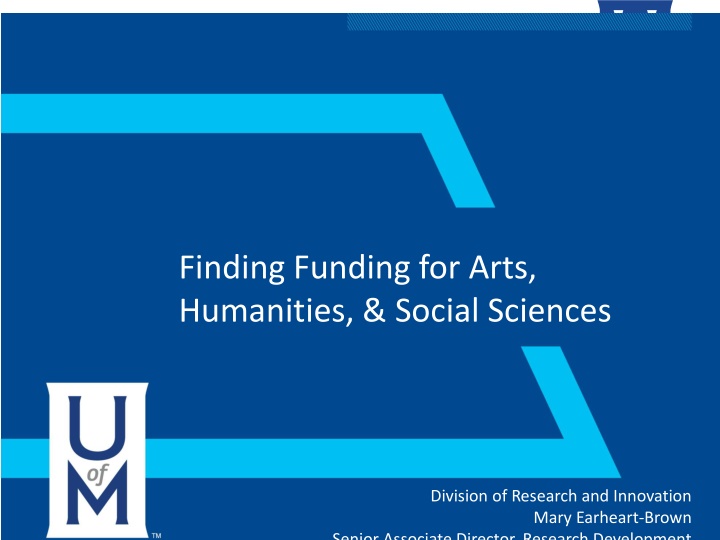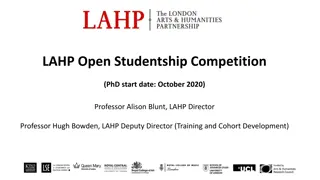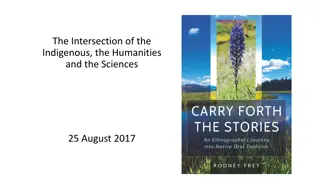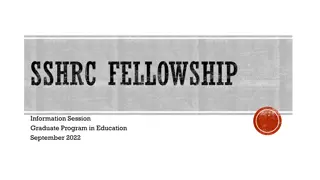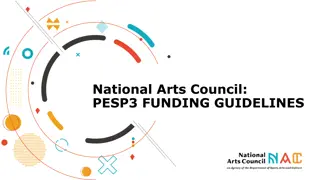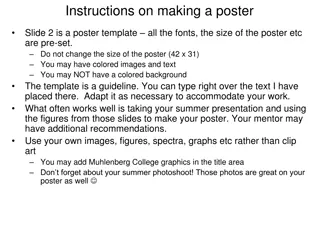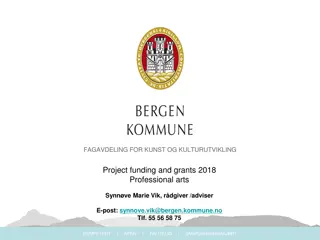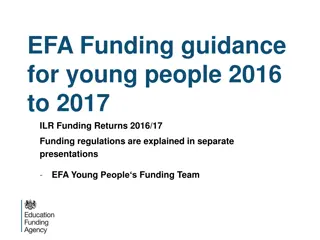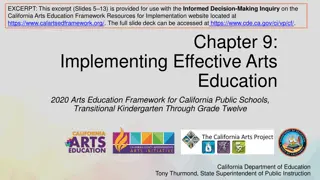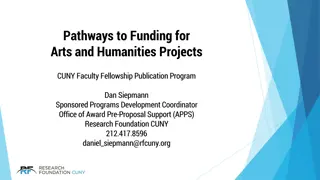Top Ten Ways to Find Funding for Arts, Humanities & Social Sciences Research
Unlock a wealth of funding opportunities for your research in arts, humanities, and social sciences with these top ten strategies. From leveraging Google's search capabilities to exploring specialized discipline resources and directly targeting federal sponsors, these methods will guide you towards securing the financial support you need to advance your scholarly pursuits.
Download Presentation

Please find below an Image/Link to download the presentation.
The content on the website is provided AS IS for your information and personal use only. It may not be sold, licensed, or shared on other websites without obtaining consent from the author.If you encounter any issues during the download, it is possible that the publisher has removed the file from their server.
You are allowed to download the files provided on this website for personal or commercial use, subject to the condition that they are used lawfully. All files are the property of their respective owners.
The content on the website is provided AS IS for your information and personal use only. It may not be sold, licensed, or shared on other websites without obtaining consent from the author.
E N D
Presentation Transcript
Finding Funding for Arts, Humanities, & Social Sciences Division of Research and Innovation Mary Earheart-Brown Senior Associate Director, Research Development
Top Ten Ways to Find Funding for Your Research With Apologies to David Letterman
10. Just Google it. This may sound simple, but the folks at Google have an excellent algorithm. Take advantage of it. (Your brand doesn t become a verb unless you are very good at what you do!)
9. Go where the foundations go. Check out the Council on Foundations. This is where the funders (corporate givers, foundations, and other institutions) seek counsel. See what is trending in the philanthropic world at this site.
8. Visit the Research website of other universities. Check out the websites of research/sponsored program offices, research centers and departments at major universities. Here s the UofM site.
7. Go directly to targeted sponsors websites, especially if you are interested in federal awards. Federal websites often have a listing of their own grants, including available funding, projects funded, and tips for success. Grants.gov National Endowment for the Humanities Substance Abuse and Mental Health Services Administration (SAMHSA) National Institutes of Health National Science Foundation
6. Check out resources in your discipline. Many professional associations offer grants and fellowships. Some also provide listings of funding related to the field. Here are a few to consider: American Psychological Association American Educational Research Association American Association of University Women International Literacy Association
5. New to sponsored projects? Start small. Look into funding from UofM, local or state funders. University or college-based grants Community Foundation of Greater Memphis Humanities Tennessee Tennessee Higher Education Commission
4. Explore collaborative projects with colleagues, especially in the natural sciences and engineering. Many natural science and engineering grants (e.g. NIH, NSF) suggest that the PI form a multidisciplinary team. Making meaningful connections with other scholars on campus can lead to productive collaborations. Track the regular faculty development sessions that are held by other departments, and try to attend when possible. These presentations can lead to conversations and organic relationship-building. Watch for the announcement of recently formed Communities of Research Scholars (CoRS), which are interdisciplinary research teams working on projects of common interest.
3. Check out your successful peers. Find out who in your field is being funded to do what you want to do. Who funds them? Do your homework regarding these funding agencies. Can you have a conversation with a program officer? Do you need more publications to be a serious contender?
2. Learn how to use GrantForward, a subscription database that the Division of Research and Innovation provides. GrantForward is a comprehensive, editorially maintained database of funded opportunities designed for faculty, staff researchers and graduate students. GrantForward has several great features like creating a profile by uploading your CV, which will get you grant recommendations based upon your research interests. GrantForward not only provides access to sources of funding, but can link you to collaborators inside and outside of the UM.
1. Faculty can schedule an appointment with their Research Development support person. Research Development is housed in the Division of Research and Innovation. Staff work with faculty to refine their research agendas, forge collaborations on and off campus, offer advice to make proposals competitive, and find funding opportunities. Mary Earheart-Brown supports the College of Education, the arts and humanities, social sciences and other areas. Contact ResearchDev@memphis.edu if you aren t sure who supports your discipline.
Summary Finding funding, isn t magic, but does take some persistence. The order of this Top Ten List is mostly arbitrary. We hope we have introduced some strategies that are new to you. For additional information, please go to our website.
